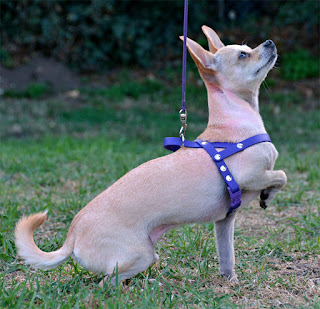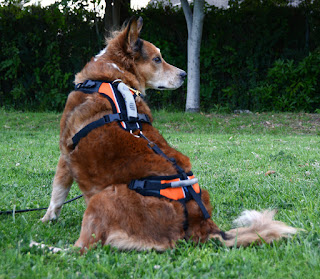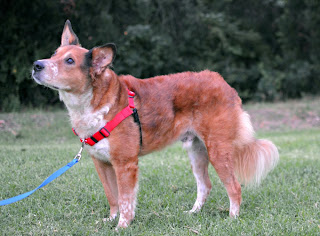 |
| Ru models his custom Fraggle Rock biothane harness. Photo by Erin Koski |
 |
| Josie in the Kurgo Go-Tech Adventure Harness Photo by Erin Koski |
2. My dog is very old.
A harness can give a senior dog a helping hand. Whether they need a little help getting down the stairs or a lot of help just standing up, the right kind of body harness can provide the needed support.
3. My dog is disabled.
Harnesses are also awesome for differently able pups of all sorts, from tripods to blind dogs. Many manage to compensate in amazing ways, but a harness can allow them to do it all, keep them safe, and provide support to give their working parts a rest.
 |
| Brisbane rocks the Help 'Em Up Harness Photo by Erin Koski |
3. My dog is injured.
Years ago, when we first x-rayed Brisbane's sore back, a veterinarian recommended I use a harness for him on a regular basis. Whether the problem is in the tails, the middle of the back, or the neck, he told me that it was best to distribute pressure and not pull Brisbane around by one end of his spine. Some harnesses also help provide support for dogs with reduced mobility.
 |
| Ru in the Midnight Pet paracord harness attached to the Flexi Mini. Photo by Erin Koski |
4. I want to give my dog more freedom.
Though I'm not a fan of retractable leashes in most situations, I do use Flexis for certain outdoor adventures with my crew. When I use any kind of extra-long leash, I always attach it to a harness. This protects my dog's neck in the unlikely event that something causes them to bolt to the end of their leash. I can't predict earthquakes, poorly-timed fireworks, or stealthy joggers with no personal space, but I can make sure that the pressure is distributed across my dog's chest when they suddenly stop after accelerating for 15'.
 |
| Hellin wears the Mhu Ghu LED mesh harness Photo by Erin Koski |
5. My dog doesn't know how to walk on a leash yet.
While I've found collars to be more useful for communicating with a dog via a leash, harnesses are preferable for casual outings with dogs who are still figuring out this whole "leash" thing. Whether I'm working with a new puppy or a rescue fresh from the shelter, I want to protect their neck while they learn to move with me.
 |
| I like the SENSE-ation harness a lot better than the Easy Walk. Photo by Erin Koski |
6. I don't want my dog to pull me.
Loose leash walking is a skill that must be learned, and many dogs need a lot of exercise while they are mastering the concept. There are a wide variety of harnesses that can help discourage pulling while preventing a strong dog from overpowering a smaller handler. Some regular Roman harnesses can be used as a front-clip no-pull harness.
 |
| The Urban Trails mushing harness by Alpine Outfitters. Photo by Erin Koski |
7. I do want my dog to pull me.
Mushing isn't just for winter anymore! There are a wide variety of dog-powered sports and activities out there. If I'm asking my dog to pull me on a skateboard, scooter, bicycle, or skis, I need to make sure he is comfortable. Harnesses designed for pulling tend to be thickly padded around the chest to help distribute pressure. Some dogs will cheerfully pull on a collar, but this can cause damage over time.
 |
| The Ruffwear Webmaster harness allows me to carry Brisbane like a suitcase. Photo by Erin Koski |
8. I need to pick my dog up.
Whether I am helicoptering my chihuahua out of harm's way or helping Brisbane up a particularly steep section of trail, a harness is essential for comfortable lifting. Not every harness is designed for this, though many can be used for emergency lifts. Those used for rappelling and parachuting have straps that go around the rear legs for extra security.
 |
| Brisbane holds a perfect stay while I take off the SENSE-ation harness and put on the DT Works harness. Photo by Erin Koski |
9. I need my dog to pick me up.
 |
| Annie, on the right, is the most talented escape artist I know. |
10. My dog can escape from any collar.
I know a dog that can escape from martingale, slip lead, any type of head halter, and most harnesses. So far the only thing that can securely contain her is the Ruffwear Webmaster harness, and a prong collar. The Freedom No-Pull harness is also more difficult to escape than the average harness, though foster puppy Hellin managed it a couple of times.
Do you use a harness for your dog? Why?
No comments:
Post a Comment